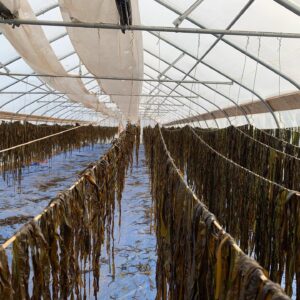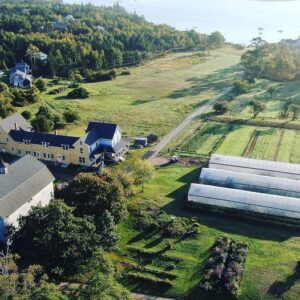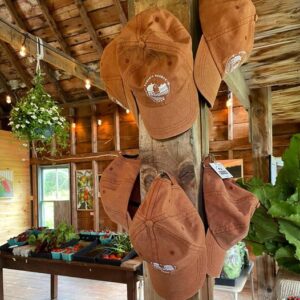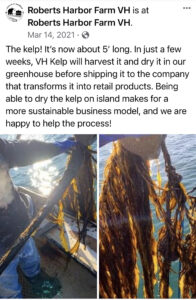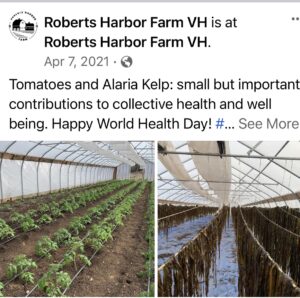Final report for FNE21-987
Project Information
This SARE grant was to help support exploration of a synergistic collaboration on Vinalhaven Island between a land farm (Roberts Harbor Farm) and an aquaculture farm (Vinalhaven Kelp, Inc.) to repurpose a greenhouse for one month, April, to facilitate drying operations for the kelp crop. This would increase the income potential of land based and aquaculture farmers by using their existing investments and knowledge in a synergistic way. Potential income for kelp triples from $.50 per pound for wet kelp to $1.50 per pound for dried kelp. The use of a greenhouse owned by Roberts Harbor Farm would avoid having Vinalhaven Kelp invest in land and buildings to accommodate the drying and packing operation. It would also provide use for Roberts Harbor Farm's third greenhouse in off season with additional rental income for Roberts Harbor Farm. The kelp farm and Roberts Harbor Farm are within 5 miles of each other reducing the cost and pollution of transporting the raw product, kelp, to a processor, over 20 miles by sea then 70 miles by truck. Roberts Harbor Farm committed to providing promotional activities at the farm and on their Facebook page and the selling of alaria flakes at their farm store during the summer and fall months. They also committed to developing recipes for kelp use applications and selling ready meals using the alaria flakes. The intent of this model, if proven successful, would be easily expanded along the Maine coast where farms and aquaculture operations are often in close proximity.
In order to prove whether this model would work, four questions had to be answered. What would be the impact to a shortened growing and harvest season for the kelp farm and seed planting at the land farm? What were the opportunity costs for the land farm in getting crops started later in the season? Would drying of a salt water crop (alaria kelp) do harm to the growing soil of the land farm? Was there a new business opportunity for both the land and sea farm when dried kelp product was added to the farm produce revenue stream and incorporated with farm stand ready meals?
The results were mixed and shared with both the Roberts Harbor Farm manager and the farm owners and other kelp growers in the Penobscot Bay area. While there was little impact on seedling planting for Roberts Harbor Farm, the Vinalhaven Kelp sea farm alaria was harvested too early in March vs April due to time constraints at the land farm. As a result, yields averaged 3-3 1/2 lb per foot vs the 4 lb per foot measurement with a wet to dry alaria ratio of 14-1 (14 lb wet alaria to 1 lb dry alaria) vs the industry standard of 10 lb wet alaria to 1 lb dry alaria. Land farm crops were planted in mid April in time for Memorial Day sales and Roberts Harbor Farm actually increased their revenue stream by $1200 in rent paid by Vinalhaven Kelp. There was a definite impact on the growing soil of Roberts Harbor Farm as indicated in the attached sodium and soluble salt results. Testing of the soil in September, November and December indicated higher levels of both sodium and soluble salts due in part to types of fertilizers used by Roberts Harbor Farm as well, according to farm manager, Kate Ritz. Lastly, there was a limited supply of flaked alaria for sale at Roberts Harbor farm store, due to supplier issues. However, some recipes were developed by Roberts Harbor Farm's chef and the kelp was incorporated in some of the ready meals sold at the farm store.
Objectives:
1. Will an acceptable kelp crop yield result in planting three weeks early, Nov, and harvesting three weeks early, April? Normal yield is 5 to 8 lbs. wet weight per linear foot. Measurement: Yield 4 lbs. per foot or greater.
2. What will the opportunity cost be for the land farmer in getting greenhouse crops started later in the season? Can this opportunity cost be mitigated by informed farm management? Measurement: Impact less than $1,800 on annual sales.
3. Will drying a saltwater crop in the land farm greenhouse harm the soil or greenhouse environment? Measurement: Negligible impact to the greenhouse soil.
4. Will this operation expand the farms consumer sales to include kelp products in the current inventory of farm to table products? What strategies need to be employed to maximize the sale of compatible land and aquaculture products? Measurement: Kelp sales greater than 5% of farm sales.
Vinalhaven is the largest populated unbridged island in Maine, sixteen miles via ferry to Carver’s Harbor from Rockland, Maine. It has a fulltime population of 1200 that grows to between 4,000 and 5,000 in the summer. Half the fulltime residents are fishermen or members of their families. Vinalhaven is the third largest lobster port in Maine. The Island has a Medical Center, school, serving 170 students K through 12, stores, churches, a library, and restaurants that serve a vibrant and diverse community.
Vinalhaven Kelp is a “C” corporation started by 10 residents, mostly fishermen, with the intent to model a business opportunity for fishermen in their off season that could supplement their income now, and in the future replace income if the lobster stocks decrease. Roberts Harbor Farm is a family owned business sized to meet the seasonal demand for locally grown fresh products.
Kelp farming is a rapidly expanding sector in Maine food production, with over 30 new farms established and a significant growth in landings over the past decade. Traditionally, kelp farming consists of planting, harvesting and sending the raw product to a large-scale processor who transforms it into a consumable product. Most kelp farmers are reliant on this model for sales and distribution of their raw crops because it allows high volumes of kelp to be grown and sold, and because individual farmers do not have access to costly processing equipment and space. However, accessing these processors can be challenging and costly for many sea farms that are small or geographically distanced, like Vinalhaven Kelp. Local and economical crop processing, like drying, is an opportunity to save costs and add value to these operations. Adding drying to the process creates a financial reward three times greater, $.50 per pound vs $1.50 wet weight.
The grant applicants proposed to use an existing land farm greenhouse owned by Roberts Harbor Farm, in the month of April to dry and process the kelp grown by Vinalhaven Kelp. This synergism could create a model in which kelp farmers can expand their financial returns without major capital investments and create new uses for idle land farm buildings for land farmers. However, there are four important questions that needed to be answered to prove this approach:
- To minimize the impact to the land farmer’s growing season, the harvesting and drying process must be done in the month of April. The normal growing season for kelp is Dec to May. Will an acceptable kelp crop yield result in planting three weeks early, Nov, and harvesting three weeks early, April?
- What will the opportunity cost be for the land farmer in getting greenhouse crops started later in the season? Can this opportunity cost be mitigated by informed farm management?
- Will drying a saltwater crop in the land farm greenhouse harm the soil or greenhouse environment?
- Will this operation expand the farms consumer sales to include kelp products in the current inventory of farm to table products? What strategies need to be employed to maximize the sale of compatible agriculture and aquaculture products, such as combining squash and kelp to make a delicious soup.
Vinalhaven Kelp started its fourth growing season in 2021 and the 2021 crop was seeded/planted on November 12, 2020. Roberts Harbor Farm started its second successful season in 2021. Previously, Vinalhaven Kelp had grown its crop and sold it to Atlantic Sea Farms (Saco, Maine) in a raw state to be processed and transformed into value-added products. Vinalhaven Kelp attained MOFGA (Maine Organic Farmers and Gardeners Association) organic certification for both its aquaculture and processing operations. Roberts Harbor Farm followed all organic practices but had not yet applied for Certification. All land farm operations were managed using organic and sustainable practices.
Roberts Harbor Farm, the land farm, is a small, 2 acre, family owned farm sized to sell only to full-time and seasonal residents of Vinalhaven Island. Started in 2020, the farm grows farm-to-table crops. Annual sales were unavailable but estimated to be in the $100,000 range. In 2021 the farm offered a wide range of fruits and vegetables as well as ready meals prepared by their chef in a commercial kitchen on the farm.
Vinalhaven Kelp was started in 2017 and two of its members have 4 LPAs each for a total of has 8 LPAs (Limited Purpose Aquaculture) Licenses) in Penobscot Bay off inVinalhaven. Each LPA is 400 feet in length. There is a total of 1600 feet of line for each of the two sites. In 2021 the farms yielded 7800 lb total wet alaria kelp. A combination of dry and wet alaria kelp was sold to Springtide Seaweed who ground the alaria into flakes and sold on the open market. Vinalhaven Kelp purchased dried, flaked alaria from Springtide Seaweed and sold the product in Roberts Harbor Farm's farm store. In 2022, Vinalhaven Kelp estimates a yield of 15,000 lb wet sugar kelp and is selling to The Crop Project in South Portland, Maine.
Cooperators
- - Technical Advisor
Research
Measurement: Yield 4 lbs. per foot or greater.
The largest market demand for dried kelp we found to be alaria kelp. Previously, Vinalhaven Kelp had grown sugar and skinny kelp varieties. Farming practices to growing alaria kelp were almost identical to the species we have grown in the past. While there was not any new seeding, growing or harvesting practices, founders of The Maine Seaweed Exchange agreed to serve as our mentors for the growing, drying and processing operations. We purchased certified, organic seed from Springtide Seaweed (affiliated with the Maine Seaweed Exchange) on November 11, 2020. We predicated our business planning models on the possibility of a lower than normal, 4 vs 5 to 8 lbs. per ft. yield for the 2021 harvest. The planting took place November 12, 2020. Seed was tended biweekly through the winter and harvest, weather permitting, and drying operation took place from March 15th-through April 17th. We averaged between 600 and 800 lb of wet alaria daily over 12 days of harvesting. Each lobster crate held between 50-60 lbs of wet alaria. The harvest boat deck and all harvesting materials including lobster crates and knives were sanitized prior to harvest. Harvested kelp was landed at the Fisherman’s COOP in Carver’s Harbor and weighed each day at the production site (land farm) prior to drying. Weight per foot of harvested was calculated at between 3-3 1/2 pounds per foot (below estimated per ft yield). Daily wet weights and dry weights from each batch were recorded on the kelp receiving logs.
From the COOP floats the harvested wet kelp was trucked to Roberts Harbor Farm, 3 miles from the COOP. Each production day dried kelp from the previous day was packed, weighed and transported to the storage shed area. With minimal heat and circulating air, the first stage of drying in the greenhouse was typically 24 hours. Inclement weather (rain and fog) extended drying time from 24 hours to 36-40 hours. After product was dried, the product was packed in food grade bags, sealed and labeled indicating date of harvest, species and date of pack-out. Ratio of wet to dry kelp was estimated at 10-1 (10 lb wet alaria to 1 lb dry alaria). However, Vinalhaven Kelp ratios averaged 14-1 (14 lb wet alaria to 1 lb dry alaria). The dried alaria was stored in the farm retail store (empty for the winter months) in an dehumidified environment for storage. 2 dehumidifiers were placed in the retail store area and cardboard boxes were arranged on racks holding the packed, dried alaria. The bags were shipped to the customer, Springtide Seaweed for further processing and retail sale in late April. The energy, oil for heat and electricity, used to do these operations was recorded using the month of April as our unit of measure.
Figure 1: Kelp drying in the greenhouse.
Measurement: Impact less than $1,800 on annual sales
Roberts Harbor Farm has three greenhouses. Each greenhouse is the same design, 96ft long by 20ft wide. Based on 2020, Roberts Harbor Farm calculated a revenue per greenhouse for their two existing greenhouses. At the end of the season, November 2021, the Farm calculated the revenue and compared the revenue for the two older greenhouses vs the one used for kelp drying in March (originally slated for April). Because of a late start to planting in the third greenhouse Roberts Harbor Farm had estimated a reduction of revenue of $1,800. As it turned out, Roberts Harbor Farm was able to start their crops on time in mid April for Memorial Day and actually added $1200 to their bottom line with rent paid to the farm by Vinalhaven Kelp Inc.
Measurement: Negligible impact to the greenhouse soil
Soil in the kelp drying greenhouse was tested for PH, metals, and minerals. Tests were done on greenhouse 1 (used to dry alaria) the end of January 2021 with the control greenhouse #2 on February 1, 2021. On May 21, 2021 after the drying of alaria had taken place, test were run again on greenhouse #1 and #2 . Testing was done again on greenhouse #1 in September and November. A final test on both greenhouse #1 and #2 took place the end of December. All results can be found here: Soils tests results Vinalhaven Kelp. It was obvious from sodium ppm and soluble salt results that there was a major impact to the greenhouse soil by drying the alaria in the greenhouse, despite putting down heavy tarps on the ground. Much of the salt condensation sat on the plastic in greenhouse. However, sodium and soluble salt levels were high in the control greenhouse #2 due to the types of fertilizers used later in the growing season, verified by Roberts Harbor Farm manager, Kate Ritz.
Figure 2: Roberts Harbor Farm
Measurement: Kelp sales greater than 5% of farm sales
In 2020 Roberts Harbor Farm sold their produce at a farm stand at the farm. In 2021 the sales operations were expanded and housed in a separate building on the farm. While the farm sold their products in 2020 they also sold a few other local products, honey and maple syrup. The local product line expanded in 2021. Roberts Harbor Farm sold cooked food featuring fresh farm produce with addition of a commercial kitchen at their farmhouse. This was for on premises consumption and take out. Food preparation was done by a culinary trained chef from existing recipes and new innovations, including kelp flakes.
Vinalhaven Kelp in partnership with Roberts Harbor Farm was a contributor to this food plan. Some of the dried alaria kelp was milled by Springtide Seaweed and returned to Vinalhaven for packaging and retail sale. Consumer interest in kelp was generated by the food being prepared on the farm. Unfortunately Springtide Seaweed was slow to get the alaria ground into flakes so only 30 - 8 oz bags were sold at the farm during the 2021 season. SARE grant funding was necessary to get this aspect of the plan accomplished.
At the end of the Farm season, November, total sales for the Farm were tabulated and the sales of Vinalhaven Kelp as a percentage of those sales were calculated. Kelp sales were not greater than 5% of farm sales as product volume and were limited due to Springtide Seaweed's lack of adequate supply to sell back to Vinalhaven Kelp.
Figure 3: Roberts Harbor farm store.
Result: There was an adverse impact of shortening the growing season and harvesting from mid March to mid April. The land farm needed the greenhouse starting 3 weeks earlier than expected. Instead of a 10-1 ratio (wet to dry) we experienced on average 14-1 ratio (wet to dry) on most of the Alaria Kelp crop. Measurement yield was 3 lb per foot or greater. Additionally, we planned to dry up to 1,500 lb of wet alaria a day. Weather conditions and space restraints allowed up to 900 lb drying per day maximum. Additionally we found it difficult to get a consistent workforce and our fishermen members who had harvested the product, myself and several Board members often hung the product to dry.
Measurement: Impact less than $1,800 on annual sales.
Result: The land farm received $1,200 in rent and were delayed only two weeks with getting the greenhouse crops started. All drying equipment was removed from the greenhouse by April 17, 2021. There was no impact on annual sales for the farm.
Measurement: Negligible impact to the greenhouse soil.
Result: Soils test were done on 1/29/21 on greenhouse #1 (where alaria was dried) and on 2/1/21 on control greenhouse #2. Sodium levels were at. 700ppm and soluble salt levels at 2.48cm on greenhouse #1. Greenhouse #2 had lower levels of sodium at 308ppm and soluable salts at 1.42cm. There was a no activity in either greenhouse at the time. On 5/21/21 after removal of kelp drying operation, greenhouse #1 sodium levels were at 1142ppm with soluble salt levels of 4.11cm while greenhouse #2 showed 2641ppm for sodium and sodium levels of 5cm. Testing on 9/3/21 showed greenhouse #1 sodium levels down at 958ppm and soluble salts at 3.44cm. On 11/19/21 greenhouse #1 sodium levels increased to 1329ppm with soluble salts 2.86. On 12/29/21 sodium levels were recorded at 1819ppm with soluble salts at 4.96cm. Greenhouse #2 sodium levels were at 1406ppm and soluble salts at 2.63cm. (all reports attached). It would appear early reports reflected sodium in the fertilizers used at the greenhouse and that residual salt condensation from the greenhouse plastic continued to add salt to the soil.
It is obvious the salt from drying the alaria condensed on the plastic of the greenhouse and that the plastic and soils should have been flushed prior to planting. There was even salt residue on some of the plant (cucumber) leaves. The residual salt decline and increase might have also be due to the sodium levels in the fertilizers that were used according to the farm manager.
Measurement: Kelp sales greater than 5% of farm sales.
Result: Our sales of dried alaria flakes purchased back from Springtide Seaweed after they had ground our dried whole leaf product were highly successful. We sold out both times but quantities were limited due to limited availability from Springtide Seaweed. We sold 30 - 8 oz bags at $9.00 per bag with 20% of the profits going to Roberts Harbor Farm. The public loved the fact they were buying flaked alaria grown by a Vinalhaven Kelp farm. Using the farm's website, advertising materials adjacent to the dried, bagged alaria and the MOFGA logo on the bags were successful sales strategies. We provide examples of the labels here: front (Dried alaria labels) and back (Dried alaria labels2).
Positive results: Community
Vinalhaven Kelp developed a great working relationship with Roberts Harbor farm manager, Kate Ritz and other workers on the farm. By employing primarily high school students, Vinalhaven Kelp was able to establish an awareness of and appreciation for aquaculture as an alternative revenue stream and opportunity for traditional lobster fishermen. Further Vinalhaven Kelp received overwhelming support from the community at large and farm clients in particularly as the ground alaria flakes in the Roberts Harbor farm store.
Negative results: Farming practices
The downsides of the project were diminished yields and premature harvesting due to time constraints on the greenhouse. This was the first time Roberts Harbor had leased a greenhouse in the off season and planting projections were a bit premature as well. Vinalhaven Kelp was to use the greenhouse during March and April for drying. Unfortunately the time frame was a bit tight as Roberts Harbor Farm needed the greenhouse to begin their seedlings in mid April, thus lowering input and profitability as the remaining alaria had to be sold wet. Kelp harvesting would ideally have taken place in April with the use of the greenhouse for the entire month of April.
Our hypothesis:
Using an existing land farm greenhouse during the month of April to dry and process kelp grown by Vinalhaven Kelp, a sea farm would result in the creation of new options for kelp farmers to expand their financial returns without major capital investments and create new uses for idle farm buildings for land farmers.
Our research conclusions:
1. Will acceptable kelp crop yields result from planting three weeks early in November and harvesting three weeks early in April for Vinalhaven Kelp? The answer to this question is no. Target yield was 4 lb per foot or greater. Actual yield was between 3 and 3 1/2 lb per foot. Alaria should have been kept in the water to provide further growth until late April for yield target.
2. What will the opportunity cost be for the land farmer in getting greenhouse crops started later in the season? Can this opportunity cost be mitigated by informed farm management? Drying alaria through mid April put the farm behind 2 weeks in planting cucumber crop. However, they did receive $1200 in rent which was a benefit to the farm. Crop was actually ready for Memorial Day weekend so there was no hardship for Roberts Harbor Farm.
3. Will drying a salt water crop from Vinalhaven Kelp in a Roberts Harbor Farm greenhouse harm the soil or the greenhouse environment? The answer to this question is mixed. While sodium levels were elevated in the May soils test report, they started to go down in October only to rise again in December. There was obviously condensation on the plastic of the greenhouse which contained salt residue. In retrospect, the farm should have rinsed both the soil and plastic before planting crops. There is also sodium in the fertilizer Roberts Harbor Farm uses so some of the testing results are inconclusive. Testing was done in late January 2021 in greenhouse #1 (where alaria was to be hung). The control greenhouse #2 was tested in early February. At the time, greenhouse #1 was almost double the sodium level of greenhouse #2 and no alaria had been introduced. On May 21, 2021 the soil testing was done again with elevated sodium and soluble salts content. However, greenhouse #2 salt content and soluble salts was even higher than greenhouse#1. On 9/03/21 a test on greenhouse #1 shows a decrease in sodium and soluble salts but in November of 2021 sodium levels rose but soluble salt levels declined. The final test at the end of December 2021 shows an elevation in both sodium levels and soluble salt. This begs the question how much salt from condensation continued to affect the soil and how much of the fertilizer used was responsible for the high salt and soluble salt levels.
4. Will this operation expand Roberts Harbor Farm's consumer sales to include kelp product in the current inventory of farm to table products? What strategies need to be employed to maximize sales? Vinalhaven Kelp never achieved kelp sales greater than 5% of farm sales as its supplier of flaked alaria took almost 6 weeks to send the first shipment back for repackaging. The alaria flakes were sold in August and late September selling 30 bags. Featuring Vinalhaven Kelp on the Roberts Harbor website, developing a point of sale sheet for Roberts Harbor Farm farm store and being included in the North Haven Conservation Partners meeting in July greatly helped sales. More consistent supply in a timely manner would have made a huge difference in sales.
Education & Outreach Activities and Participation Summary
Participation Summary:
Vinalhaven Kelp documented the farming to drying operations in a Powerpoint presentation (see slides -pictures- here: Vinalhaven Kelp presentation) . This presentation was given to the North Haven Conservation Partners along with an explanation of each slide from seeding of the kelp, to monitoring , to harvesting and drying of the kelp. Roberts Harbor Farm posted information about the drying operation and collaboration on their website and social media and highlighted our mutual efforts at their farm store.
Two sets of visitors observed the operation from outside the greenhouse and learned about kelp farming methods and processing methods. Students from Vinalhaven High School participated in the drying process and also learned about the process of seeding, harvesting and drying the alaria. Students learned the workings of a HACCP (Hazard Analysis Critical Control Point) safety plan and the creation and adherence to sanitary requirements for products for human consumption. Students also learned about labeling and traceability requirements for food products . When the flaked alaria was brought back to Vinalhaven and packaged into 8 oz bags, point of sale materials were developed to advertise the benefits of alaria and uses. The commercial kitchen at Roberts Harbor Farm also used the product to develop a number of recipes for ready meals they sold at the farm. Recipes are still being developed and will be available in the spring of 2022.
Learning Outcomes
We discovered that at this point in our business cycle it would be more effective to continue to sell product wet to a customer, with the option that if we are successful financially this season, we look at investing in both a greenhouse and a storage shed for future years. There is another land farm with the acreage to accommodate our production needs. We are also starting to research grants to fund this expansion.
Roberts Harbor Farm is paying attention and adjusting fertilizers used (all organic) to control the sodium and soluble salt levels in their greenhouses.
Project Outcomes
The concept of synergy between and land and sea farm was appealing. However, the reality of the concept was proven to be challenging in application. The harvesting season for the kelp overlapped with the planting season for the land farm which took precedence. We need to have a separate greenhouse and outbuilding in order to control and accommodate our growing capabilities and outputs. Investment is estimated at $50,000 and this will be reviewed at the end of 2022. In the meantime, we will be selling our crop wet to a processor who will be commercially drying the product and selling back flaked seaweed for the farm stand in the summer of 2022.
Kelp farmers are always looking for alternatives to selling their crops to customers in a more profitable state. This year three options are available as another kelp drying processor is online. Atlantic Seafarms in Saco, Maine, The Crop Project in South Portland, Maine and Springtide Seaweed in Gouldsboro are all purchasing wet kelp for further processing.
We will continue to share our experience with other kelp farmers in Maine and to continue to collaborate with Roberts Harbor Farm to promote the sale and use of kelp in recipes.
